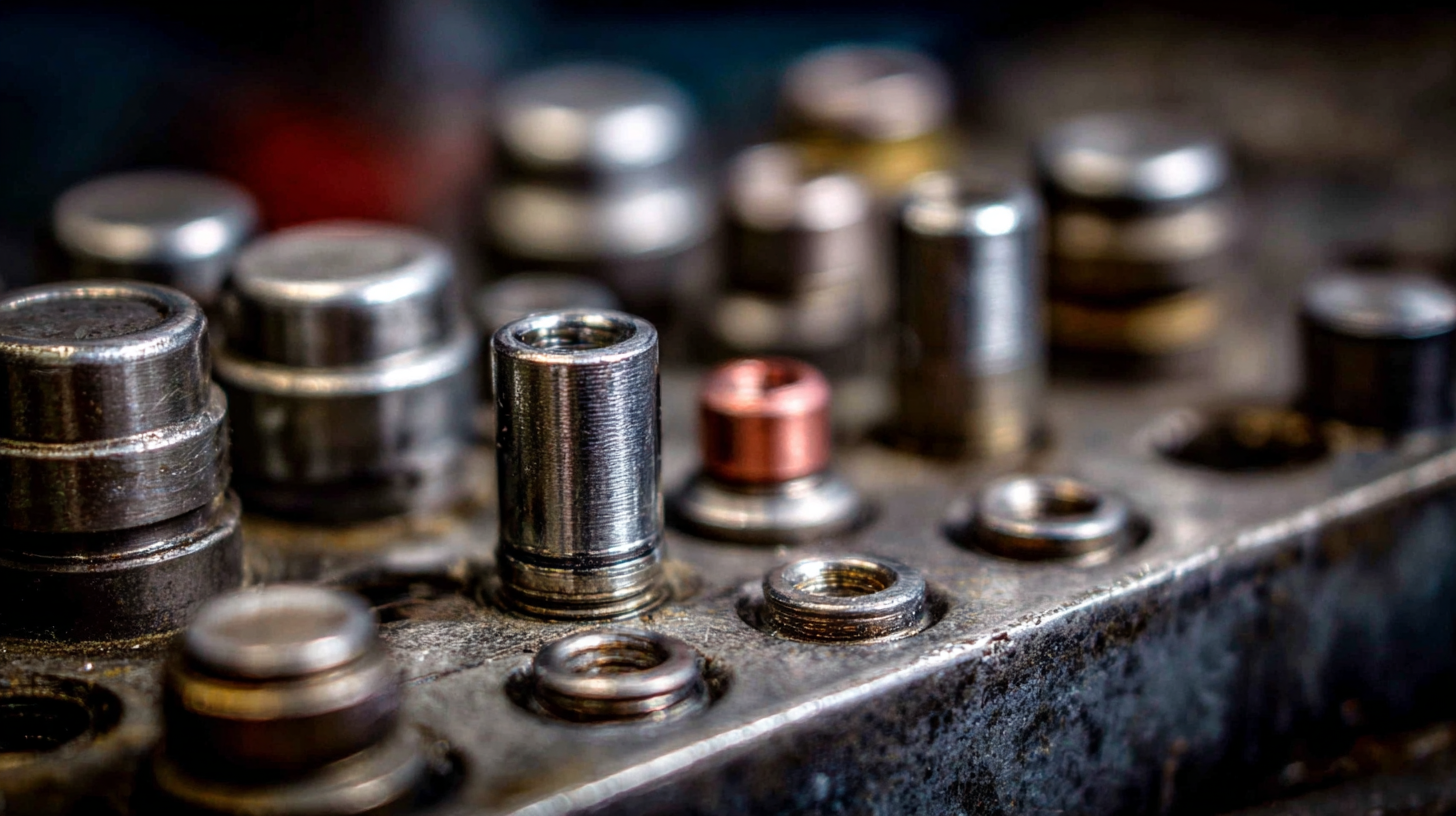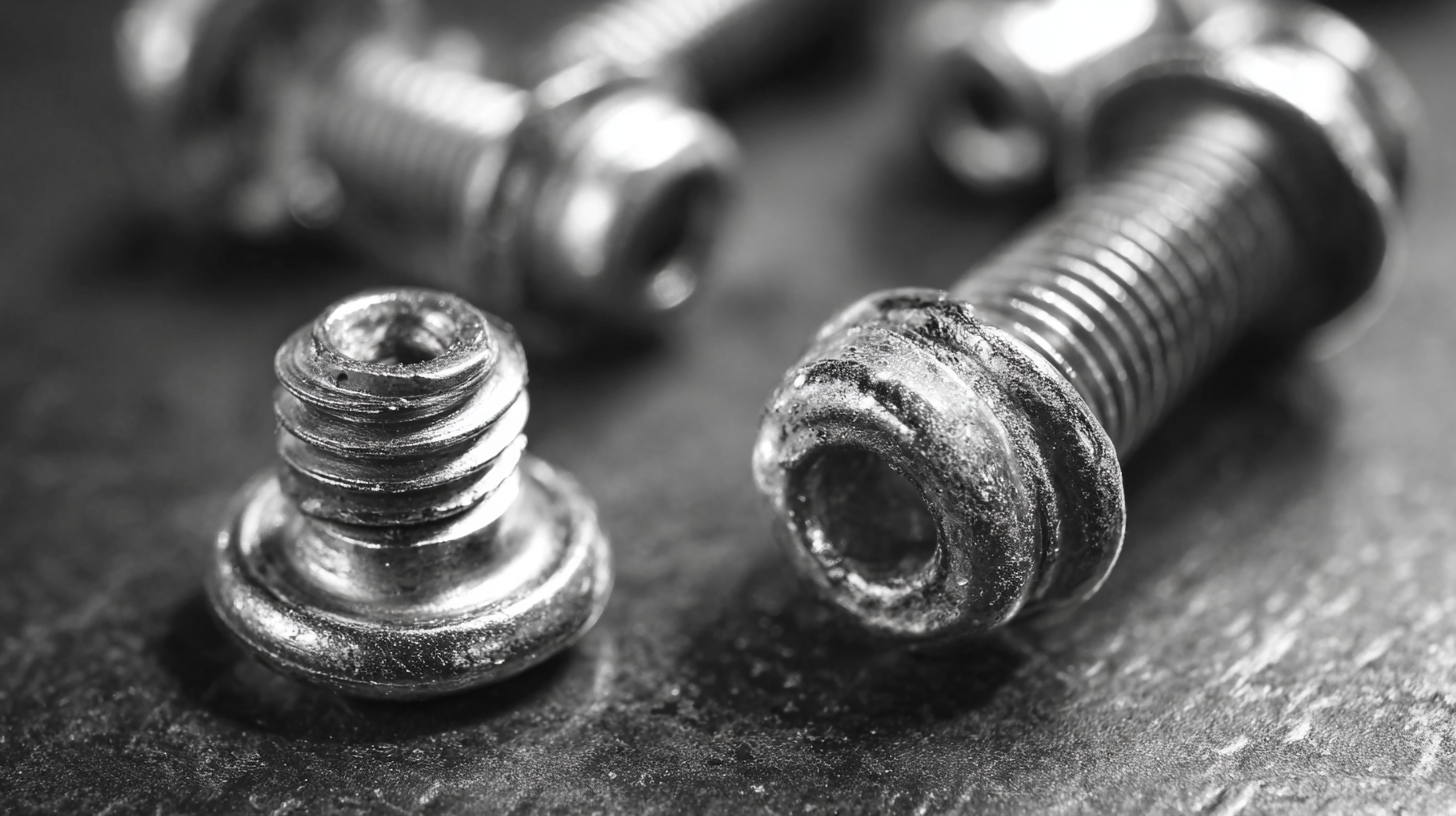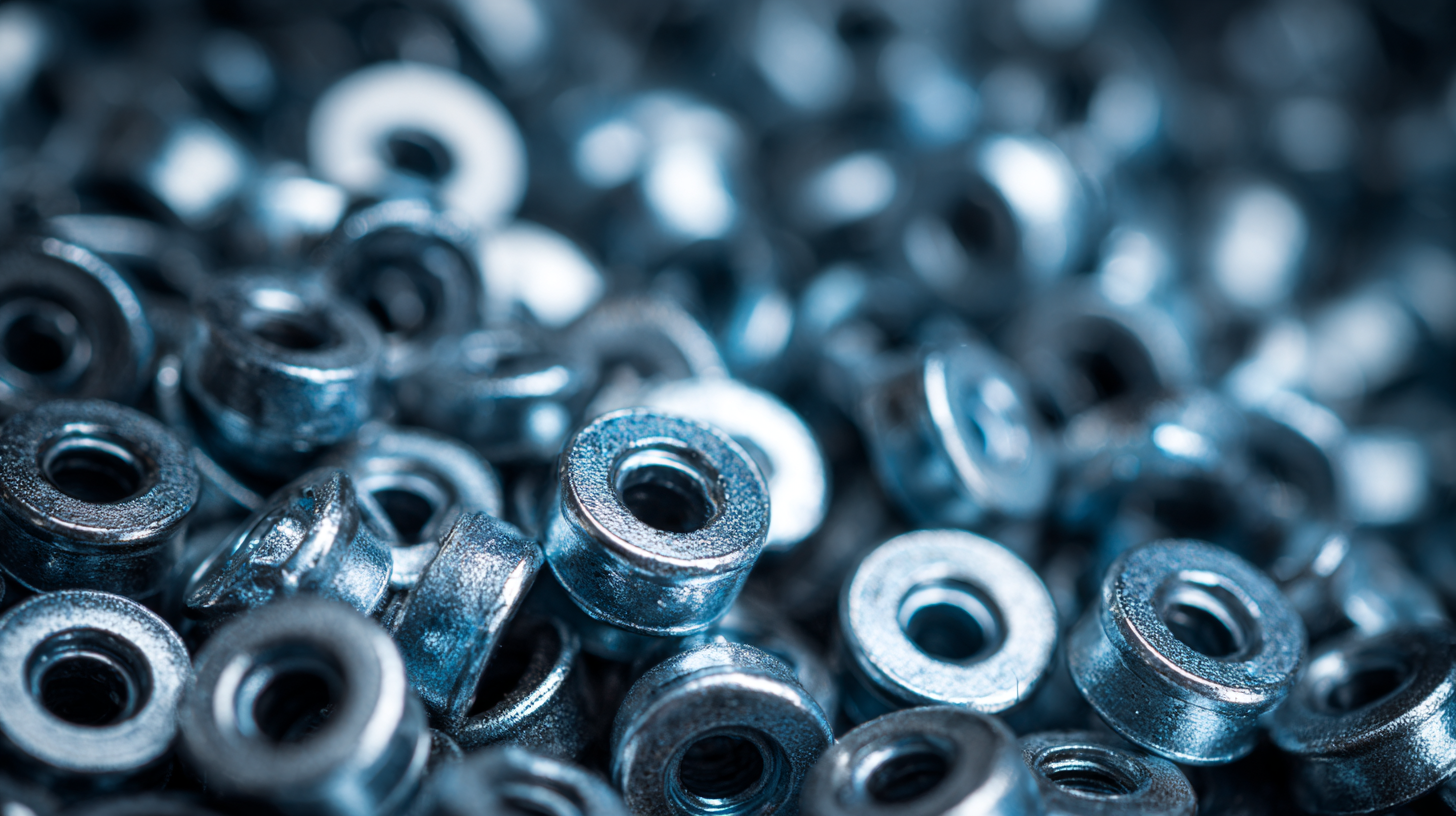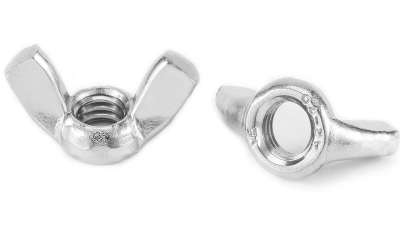
- wzqb@qb-inds.com
- Mon - Sat at 7:00AM to 6:00PM
How to Choose the Right Rivets and Clinching Methods for Your Project
Table of Contents
- Understanding Different Types of Rivets and Their Applications
- Advantages of Using Rivets in Your Assembly Process
- Comparing Mechanical vs. Structural Riveting Techniques
- Exploring Clinching Methods: Pros and Cons
- Factors to Consider When Selecting Rivets for Your Project
- Innovations in Riveting and Clinching Technologies
- Exploring the Benefits and Applications of Stainless Steel DIN315 Wing Nuts: A Comprehensive Guide to American Type Butterflies
- FAQS
- Conclusion
- Related Posts
In the fast-evolving world of high-end manufacturing, picking the right fasteners isn't just a small detail — it’s actually pretty critical for making sure your products last and perform reliably. I recently came across a report that says the global market for rivets and clinching stuff is expected to hit around $XX billion by 2025. That growth is mainly fueled by smarter automation and a rising demand for lighter materials, especially in industries like aerospace and automotive. Here at Wenzhou Qiangbang Industrial Co., Ltd., we totally get how important the right choice of fasteners really is. Since we kicked off in 2003, we’ve been all about researching, developing, and manufacturing top-notch parts that the industry depends on. With our blend of R&D, manufacturing, sales, and customer service, we’re in a pretty good spot to help clients understand the different rivets and clinching options out there — making sure they can make smart decisions that suit their specific projects.

Understanding Different Types of Rivets and Their Applications
When you're choosing the right rivets for your project, it's pretty important to get a good handle on the different types out there and what they're best used for. Rivets come in a few main types—like solid, blind, and self-piercing—and each one’s got its own niche. For example, blind rivets are a lifesaver when you can only access one side of the material. They’re often used in car body repairs or when you're working in tight spaces where drilling holes beforehand isn't really practical. The fact that they can create a solid, permanent connection without needing pre-drilled holes makes things faster — which is a total bonus when you’re working on a high-volume production line.
And don’t forget, the way you actually install the rivets matters too. Impact riveting, for instance, is super common for stuff like HVAC ductwork or even cookware. It’s known for being quick and sturdy, and lately, they've made some cool improvements that let manufacturers assemble things more precisely and faster. As people keep looking for stronger, more reliable fastening options, knowing which rivet type to go for and the best technique to use can really make a difference in hitting those quality standards and ensuring your project turns out great.
Advantages of Using Rivets in Your Assembly Process
Rivets honestly offer some pretty great advantages
that can really improve your assembly process. Unlike the usual fastening methods like
bolts or welds, rivets leave a strong,
permanent bond that can handle both shear and tensile stresses — which is super important in industries
like aerospace and auto manufacturing
where stuff just has to hold up. Plus, riveting tends to be faster overall since it usually doesn't need
as much prep, and you can often get it done in a single step, saving you time and hassle.
Another thing I love about rivets is how versatile they are. You can find them in all sorts of materials,
sizes, and shapes, so you can pick just the right one for whatever project you're working on—whether it’s metal,
plastic, or composites. And some methods, like blind riveting, are
especially handy because they let you do the job even in really tight spots where traditional fasteners might
not be an option. All in all, rivets not only make the process smoother and faster,
but they also help keep errors in check. They're genuinely a solid choice if you're aiming for a high-quality,
reliable assembly.
Comparing Mechanical vs. Structural Riveting Techniques
So, when you're trying to pick the right riveting method for your project, it really helps to understand the difference between mechanical and structural riveting. Mechanical riveting is pretty common on assembly lines—it's quick and great for high-volume stuff. On the other hand, structural riveting offers much better strength and durability, making it the go-to choice for critical parts in aerospace and automotive projects. Interestingly, a recent industry report shows that the market for structural riveting is expected to grow around 6% each year. That just goes to show how important it’s becoming in top-tier manufacturing these days.
At Wenzhou Qiangbang Industrial Co., Ltd., we're well aware of how crucial it is to pick the right riveting technique depending on what you're working on. When you're deciding, it’s smart to think about things like material thickness, how the joint is designed, and the loads it’ll need to handle.
**Pro tip:** Always take the time to analyze what your project really needs before jumping into a riveting choice. Sometimes, mixing both mechanical and structural methods — a sort of hybrid approach — actually gives the best results. And hey, keeping an eye on the latest advancements in riveting tech can really help boost your efficiency and cut down costs. With nearly 20 years under our belt in making high-quality components, our focus on research and innovation means we’re always aiming to deliver the best precision riveting solutions for our clients.
How to Choose the Right Rivets and Clinching Methods for Your Project - Comparing Mechanical vs. Structural Riveting Techniques
| Rivet Type | Application | Strength | Installation Method | Cost |
|---|---|---|---|---|
| Solid Rivets | Aerospace and automotive | High | Hammering / Heavy Machinery | $$$ |
| Blind Rivets | Sheet metal fabrication | Medium | Hand Riveting Tools | $ |
| Structural Rivets | Heavy construction | Very High | Hydraulic Riveting Tools | $$$$ |
| Tubular Rivets | Lightweight applications | Low to Medium | Hand Tools | $ |
| Clinching | Metal joining without heat | Medium | Specialized Equipment | $$ |
Exploring Clinching Methods: Pros and Cons
When you're choosing rivets and clinching methods for your project, it's really important to get a handle on the pros and cons of the different clinching techniques out there. Clinching is often the go-to for joining materials that aren’t the same, especially when you’re working with hybrid metal and polymer setups. It’s pretty cool because it offers a good mix of strength and efficiency. But here’s the thing — how well it works depends a lot on the tools and methods you use. For instance, using rectangular joints is usually a snap during assembly because they’re straightforward, but they tend to have weaker resistance to shearing forces, which might be a problem if your joint endures a lot of stress.
And don’t forget, the clinching method you pick really needs to match what your project requires. Some techniques might give you great peel strength, but they could fall short when it comes to handling shear loads. Striking that balance is key to making sure your final product performs well. Recent studies on hybrid joints have shown that the way you use different tools during clinching can really change how the joint behaves mechanically.
So, doing your homework and carefully weighing your options will definitely help you make smarter decisions — leading to better results all around.
Factors to Consider When Selecting Rivets for Your Project
When you're picking out rivets for your project, there are actually quite a few important things to keep in mind to make sure everything stays solid and lasts over time. First off, the material you're working with really matters — for example, aluminum rivets are great if you’re going for something lightweight, like in aerospace or car manufacturing. Actually, I recently read a report from Smithers Pira that says the demand for aluminum rivets is expected to go up by about 5% each year, mainly because they resist corrosion and are so light. That makes them pretty much perfect for those industries.
Another thing to consider is the size of the rivets and how much material they need to grip — that’s pretty crucial, since it has to match the thickness of what you’re attaching. The ISO has some standards that give good guidelines on how to pick the right rivets, and skipping that step can lead to joint failures. Plus, environmental factors like heat or exposure to salt and chemicals should definitely influence your choice. Sometimes, you might need special coatings or harder materials to make sure the rivets last. The Rivet Manufacturers Association also points out that if you choose the right type from the get-go, you could actually cut down on maintenance costs by up to 30% over the life of your project. So, yeah, it really pays to choose wisely from the start.

Innovations in Riveting and Clinching Technologies
 There's some pretty exciting stuff happening in the world of riveting and clinching tech these days. These innovations are really shaking up how we attach things across different industries. For example, a new double-flush riveting method has just come onto the scene, and honestly, it’s a game-changer—especially when you're working with hybrid busbars that combine aluminum and copper. Not only does it create a super strong mechanical bond, but it also tackles those tricky issues that pop up when you're dealing with different materials. It’s like a big step forward for electrical work!
There's some pretty exciting stuff happening in the world of riveting and clinching tech these days. These innovations are really shaking up how we attach things across different industries. For example, a new double-flush riveting method has just come onto the scene, and honestly, it’s a game-changer—especially when you're working with hybrid busbars that combine aluminum and copper. Not only does it create a super strong mechanical bond, but it also tackles those tricky issues that pop up when you're dealing with different materials. It’s like a big step forward for electrical work!
On the clinching side, the flat clinch-rivet process is also making waves. It’s a pretty neat technique that involves steps like positioning, extrusion, deformation, and final shaping—kind of like a mini assembly line inside the process. It really helps in joining sheet metals more reliably, and you end up with a tight, durable connection. Plus, it’s faster, too, which means better production speeds and less downtime.
Researchers are even digging into how these clinched joints hold up over time, looking at things like fatigue crack growth—that’s super important for making sure these joints last under stress. All in all, these advances are making clinching more popular among manufacturers who want quick, cost-effective ways to get the job done right without sacrificing quality.
Exploring the Benefits and Applications of Stainless Steel DIN315 Wing Nuts: A Comprehensive Guide to American Type Butterflies
Stainless steel DIN315 wing nuts, often referred to as butterfly nuts, are ingeniously designed fasteners that provide an efficient solution for various applications. Characterized by their two large wings on either side, these nuts can be effortlessly tightened or loosened by hand, eliminating the need for specialized tools. This functionality is particularly advantageous in scenarios where quick adjustments are required, such as in machinery setups, furniture assembly, or DIY projects. The convenience of wing nuts makes them a popular choice among both professionals and hobbyists.
Beyond their user-friendly design, stainless steel wing nuts offer superior durability and corrosion resistance compared to their counterparts made from other materials. This makes them ideal for use in outdoor settings or environments where exposure to moisture and chemicals is a concern. The versatility of these fasteners allows them to be utilized in a range of industries, from automotive and aerospace to construction and electronics. Whether securing components or facilitating easy access for maintenance, stainless steel DIN315 wing nuts enhance efficiency and reliability in any assembly task.
FAQS
: The main types of rivets include solid rivets, blind rivets, and self-piercing rivets, each suited for specific applications.
Blind rivets can be installed from one side, making them ideal for applications where only one side is accessible, such as automotive body repairs.
Impact riveting offers advantages in speed and durability, allowing for precise and quick assembly, especially in the production of items like HVAC ductwork and cookware.
Rivets create strong, permanent bonds that can withstand shear and tensile forces, making them especially suitable for critical applications in aerospace and automotive industries.
Rivets are available in various materials, including metal, plastic, and composites, allowing them to be tailored to specific project requirements.
Clinching methods provide a strong, efficient way to join dissimilar materials, particularly in hybrid metal-polymer structures, with various advantages depending on the technique used.
It's essential to align the clinching method with project requirements, balancing properties like peel strength and shear load capabilities to ensure the joint meets performance standards.
Riveting typically requires less preparation time than welding or bolting and can often be executed in a single step, speeding up production.
Some clinching methods may offer ease of use but could compromise joint integrity under stress due to weaker shearing resistance.
Thorough research and careful selection can lead to better mechanical performance in hybrid joints, improving the overall quality of the final product.
Conclusion
Hey there! In our latest blog titled "How to Pick the Right Rivets and Clinching Methods for Your Project," we dive into the wide world of rivets and how they fit into different jobs. We want to help manufacturers figure out which fasteners are best suited for their specific needs. We also chat about why rivets are such a great choice for assembly—comparing mechanical and structural riveting styles—highlighting what makes each one unique, along with their upsides and downsides. Plus, we take a look at various clinching methods, breaking down their pros and cons, and pointing out the key things you should think about when picking rivets for your particular project.
With new tech popping up all the time in riveting and clinching, companies like Wenzhou Qiangbang Industrial Co., Ltd.—who focus on high-end manufacturing parts—are really stepping up their game. By combining research, development, and manufacturing all in one, Qiangbang is able to roll out customized solutions that keep up with the industry’s ever-changing demands. This way, they ensure top-notch performance for all your rivet and clinching needs.
Related Posts
-

7 Reasons Why Best Rivets and Clinching Solutions Are Essential for Your Business
-

Top 10 Rivet Manufacturers from China at the 137th Canton Fair
-

10 Reasons Why Best Toggle Bolts Are Essential for Your Next Project
-

10 Essential Tips for Choosing the Best Threaded Rod for Your Projects
-

Understanding the Importance of Best Spring Washer in Industrial Applications
-

Exploring the Best Picture Hangers: What You Need to Know for Perfect Wall Displays

